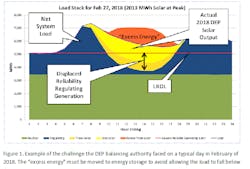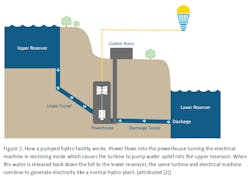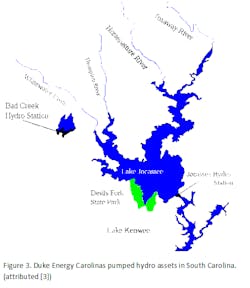Applying Flexible Resources to Store Excess Renewable Energy
Thousands of megawatt-hours of electrical energy squirreled away into utility-scale energy-storage plants to cover the spread between generated renewable energy and the lowest reliable operating limit (LROL) during the 10 a.m. to 3 p.m. “duck curve” period of the day — does this sound like a glimpse into the far future of major utilities across the United States and the world? But the future has already arrived at the Carolina operating companies of Duke Energy.
For example, the Duke Energy Progress (DEP) Company, serving customers primarily in the eastern half of North and South Carolina, managed a whopping 106 GWh of excess energy in 2017, largely generated from the vast fleet of mostly utility-scale solar-energy resources in North Carolina. “Excess energy” is generated whenever the net demand load falls below the LROL. This tends to happen during the period of the day of greatest solar energy generation, between 10 a.m. and 3 p.m., as shown in Figure 1.
A Balancing Authority (BA) is responsible for achieving continuous balance between available energy and demand for energy in real time and therefore, needs to commit generation units that can reliably meet peak demands, expected net-demand ramp rates and reserve requirements to regulate frequency and support contingency conditions.
The LROL is the minimum MW level needed to keep the required generating units online. In addition, the utility is bound by private power agreements with guaranteed “take” provisions. Between the “take” provisions and the reliability requirements enforced by NERC, the problem is two-fold: (1) maintaining sufficient local regulating reserves to manage intermittency and net-demand ramping, and (2) managing excess energy, which is not a simple matter of switching open a recloser at a large solar-generating facility or shutting down a gas-fired turbine.
All of that renewable energy has got to go somewhere. According to Kat Sico, transmission operations engineer for DEP, “When resources are available, excess energy can be managed by reducing internal generators or exporting the excess energy via the joint dispatch dynamic schedule. This energy either serves Duke Energy Carolina’s (DEC’s) retail load or utilizes DEC’s 2100 MW of pumped storage load capabilities.”
This dynamic schedule has been implemented under the Joint Dispatch Agreement (JDA), in which DEP and DEC are permitted to share “non-firm” energy in order to meet their customers’ energy demand in an economic manner. Since solar generation has guaranteed “take” provisions for DEP, the excess energy that is transferred from DEP to DEC comes from other generation resources. DEC primarily serves the western parts of North and South Carolina, a region encompassing the Appalachian mountain range, where DEC’s pumped-hydro operations are in motion.
As shown in Figure 2, the concept of pumped hydro is simple. Two reservoirs – one, the upper reservoir, and the other, the lower reservoir, are connected by a single power house consisting of dual-use turbines. When excess electrical energy is transmitted to the pump house, the massive electric machines drive the water turbines in pumping mode, pushing water to the upper reservoir and thus storing potential energy for later use. When it is time to recover the energy, the process is reversed and the water spins the same electrical machines now operating as generators.
Figure 3 illustrates the locations and arrangement of Duke Energy’s two pumped-hydro facilities. The larger and newer of the two is the Bad Creek Pumped Hydro plant, opened in 1991. The nearby Jocassee Hydro Facility began operation as a pumped-hydro project in 1975, but has been upgraded in recent years with more powerful turbines. The available energy storage from these two locations exceeds by a large margin the total installed capacity of utility-scale battery-energy-storage projects in the U.S., estimated in 2018 to be about 750 MW.
What makes the whole system work is the electrical transmission system bridging the geographical distance between the remote locations in the mountains where the pumped hydro is sited in DEC, and the loads and generating locations in the piedmont and coastal regions of DEP along with the JDA between the two BAs. The combination of transmission and ability to share “non-firm” energy makes it possible to connect the thousands of megawatts of solar capacity in the eastern half of the Carolinas, amounting to the second-largest installed capacity in the U.S., to enough pumped-hydro-energy storage to help prevent curtailment of renewable energy while allowing the DEC and DEP balancing authorities to provide reliable electric service and maintain compliance with NERC reliability standards.
However, the JDA is a strategic, economic, incremental-cost energy-transfer tool that relies on hour-by-hour, as-available, “non-firm”, curtailable transmission. There are limits to how much power can flow on the transmission system and all transfers between BAs are flexible and subject to be curtailed because of transmission-system constraints. Since the joint dispatch dynamic schedule is a “non-firm” transaction, it is even more likely to be scaled down because of constraints compared with “firm” transactions. Relying on the JDA to manage operationally excess energy poses significant system operational risks of transmission curtailment as the system was not designed as a long-term solution to manage operationally excess energy supplied by “must-take” solar energy.
In addition, DEP and DEC continue to operate as separate Balancing Authority Areas and utilities, and each is responsible for its own independent resource planning and operations, as directed by the North Carolina Utilities Commission. Regardless of the current excess energy and the pumped storage capacity, we cannot demand the use of DEC’s pumped-storage generation to mitigate operational challenges experienced in DEP. Thus, in addition to ensuring maintenance of additional local regulating reserves to manage the variability and steepening net-demand ramping, the DEP system operators have to be prepared to address the excess energy when this transfer capability is lost and/or DEC’s pumped storage is unavailable. During these situations, DEP has procedures to throttle down, first, the company’s conventional generating assets, and then, its own solar generating assets before curtailing third-party solar.
Duke Energy continues to work on managing the most demanding “duck curve” outside California. It will only become more demanding. Kat Sico warns that “as the DEC and DEP solar capacity approaches 7,000 MW in 2025, the management of excess energy will require significantly more flexible resources as well as alternative energy storage”.
In utility time, 2025 is just around the corner and you can bet that when it comes, the transmission and distribution systems will deliver an even bigger share of the energy storage solution.
The Energy Production and Infrastructure Center (EPIC) at the University of North Carolina at Charlotte is a T&D World Media Partner.
About the Author
Michael Mazzola
Dr. Michael Mazzola is the director of the Energy Production and Infrastructure Center (EPIC) and the Duke Energy distinguished chair in power engineering systems at University of North Carolina at Charlotte. After three years in government service at the Naval Surface Warfare Center in Dahlgren, Virginia, in 1993, Mazzola joined the faculty at Mississippi State University, where he became known for his research in the areas of silicon carbide power semiconductor device prototyping and semiconductor materials growth and characterization. For 10 years, he served at the Mississippi State University Center for Advanced Vehicular Systems as the associate director for advanced vehicle systems, where he led research in high-voltage engineering, power systems modeling and simulation, the application of silicon carbide semiconductor devices in power electronics, and the control of hybrid electric vehicle (EV) power trains. In addition, he served two years as the chief technology officer of SemiSouth Laboratories, a company he co-founded. Mazzola holds a PhD in electrical engineering from Old Dominion University.
Kat Sico
Kat Sico is a system operations engineer for Duke Energy. She has over four years of experience with system operations as an intern and full-time employee and has a year of experience as a co-op student between Protection and Controls Engineering and Relay Design. In her current role, she focuses on assessing power-system stability over the operational time frame. Kat graduated with an MSEE from N.C. State University in December 2014, and is a registered professional engineer in the state of North Carolina.
Steven Whisenant
Steven Whisenant is a lead engineer at Duke Energy and has over 38 years of experience in the electric-utility business, including design and analysis of electrical power systems of electric-generating stations, transmission-substation design and analysis, distribution operations, power quality for all electric customer segments, management of customer offers for large business customers, nuclear-engineering project management, power-delivery project management, and transmission-asset management.



